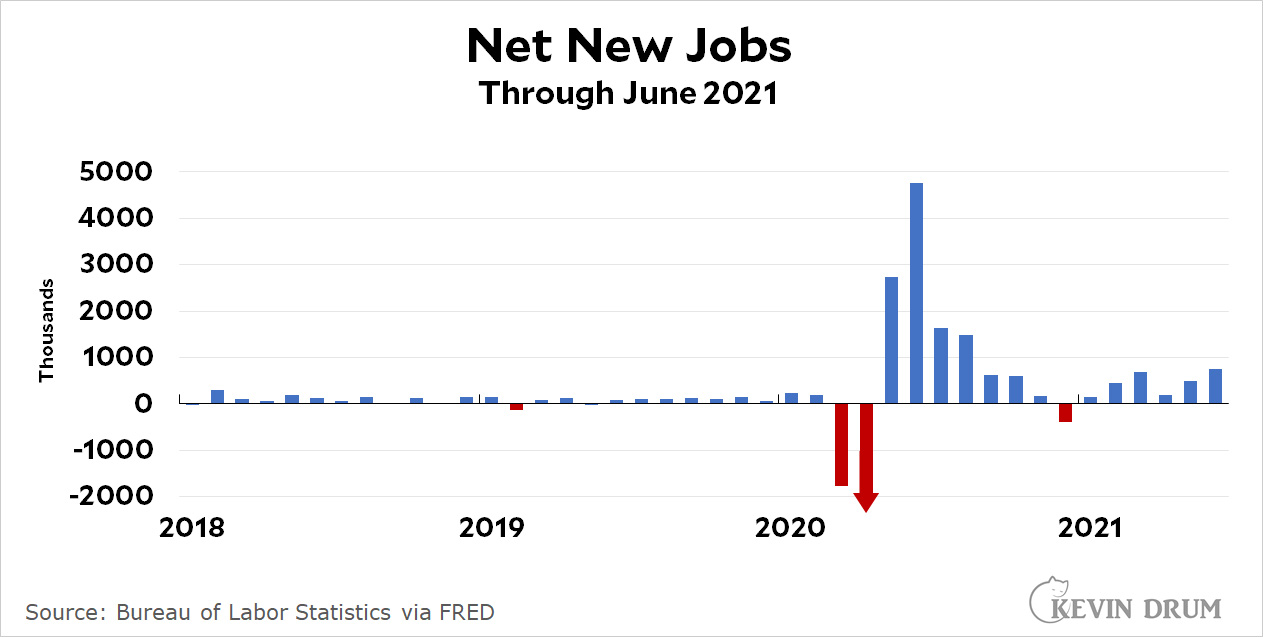The American economy gained 850,000 jobs last month. The unemployment rate increased slightly to 5.9 percent.

This is an odd report. The establishment data (i.e., reports from businesses) shows an increase of 850,000 jobs, which isn't too bad. However, the household data is miles away from this, showing that the number of employed people went down slightly in June and the labor participation rate remained steady. These two reports usually differ, so there's nothing strange about that, but they don't usually differ by quite so much. I'm not sure what's going on.
Hourly earnings were up a bit after adjusting for inflation, but weekly earnings were down considerably. Presumably this is because the average number of hours worked went down as more people got hired and there was less need for overtime.
I'm not sure what to make of all this. I think it falls into the category of "not too bad but the labor market isn't surging yet." We're still waiting for the big jobs breakout.

The winner of the pro-Independence Day holiday jobs report?
Donald Trump.
How so? It's not like he can take credit for anything at this late date. Oh, sure, he can try since he's a pathological narcissistic liar, but I mean, realistically he can't. It's Biden's economy now.
I have no love for Trump, but fairness requires giving quite a bit of credit for the current recovery to Operation Warp Speed. It's the vaccines that have turned the tide.
Yes. The same story with the Weisselberg indictment. Donnie is saying "Please, Mr. President, I don't want to win anymore."
If you look at the raw data:
Household:
https://fred.stlouisfed.org/graph/?g=FaGa
Establishment:
https://fred.stlouisfed.org/graph/?g=FaGd
there is really not much difference. Both surveys show that employment is still improving only slowly - at this rate it will be years before the pre-pandemic trend is reached. But remember that the effects of the Biden stimulus have not fully reached the economy yet. Also the pandemic is not over.
Like the media, Kevin often tries to draw too much out of small monthly differences in official economic reports.
The data and the reports on economic parameters are completely useless. That's what you should make of it. It can't possibly reflect the experiences of people in the real world. You ought to stop pretending it does.
it's not intended to reflect "the experience of people in the real world." it's intended to reflect the economy. there are people in the best of times who are unemployed; there are people in the worst economy who have jobs and do quite well. no one is pretending otherwise.
The problem is the PUA programs based around the pandemic are "bottling" up workers who should be counted as "employed". The U-6 is down to the same level when the unemployment rate was down to 5% in late 2015 shows the mess of these unnecessary programs. Going into June they represented 6.6 million workers "in freeze". By the end of the month it was down below 6 million finally, after June sampling though. Major mistake by Dem leadership to expand these programs to September 4th rather than July 4th. Getting businesses, heavily based on personal services back onto the accounting board will make the U-3 to decline sharply and LFPR to rise sharply, which likely will happen in a "surge" mostly inhabiting August/September as the benefits finally run out.
Your speech is "like" something sensible.
You ever check this out?
https://aiweirdness.com/
If you know someone suffering, help them. Rather than peruse data and reports, do something. The data don’t tell us anything about suffering. Maybe no one is suffering at all.
We do seem to be increasing our spending though - at least on things being imported: https://abcnews.go.com/Business/wireStory/us-trade-deficit-increases-712-billion-78629444
My guess is that with the economy now fully open in most states and the fact that states are ending the enhanced UI benefrits, more people are starting to look for work and so they now count as unemployed in the household survey.
That is possible, but then hiring should surge in the coming months
Interesting pattern developing as hiring grows through the quarter, then drops off - hesitancy to hire at the beginning of the quarter compounded by relatively and temporarily tight labor markets, perhaps.